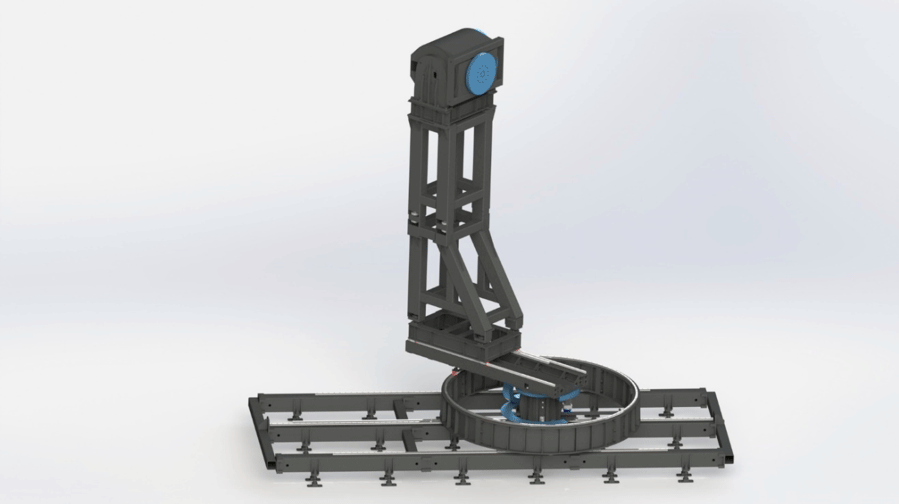
Antenna parameters far-field measurement has not only obvious advantages concerning the fact that there is no need to carry out complex mathematical operations, but also a range of requirements to bench elements resulting from necessity of precision positioning of the product under test in several (2-6) spatial axes. Therewith, one of the most complex things in multi-axis positioners is the above azimuth slider. It should have minimal bend under vertical and moment loads with hangout from attachment point to azimuth axis. Our company is the first in industry to develop a mechanism with an additional bearing of 2 m radius which takes substantial moment load off the slider. This leads to much less slider bending.
PSR series positioner axes quantity – up to 5 (optional – up to 6).
Composition
- Lower slider for positioner linear coordinate movement.
- As a rule, it is used for displacement nearer\further from collimator or for installing a positioner into the spot suitable for antenna mounting.
- Azimuth rotation axis
- Horizontal slider above azimuth.
- As a rule, it is used for mounting the antenna in the phase center in azimuth rotation.
- Vertical slider on horizontal slider above azimuth.
- As a rule, it is used for convenience of antenna mounting at human scale height. It is also used for volume radiation pattern measurement with 3-axis movement interpolation for antenna installation in the phase center at elevation movement.
- Rotation axis in polarization.
Features
The product is unique in the global market. The positioner has an outer slew ring that provides the second attachment point for the horizontal slider above azimuth. This substantially rises ruggedness of the slider and allows executing a slider with more than 1200 mm travel with minimal bending of the frame under the weight of the antenna under test.
The device employs self-produced precision mechanics, precision electronics, optical encoders, servo technics, radio technics as well as mathematical and software algorithms.
The positioner allows setting up compound or sequence multi-axis movement for volume scanning when antenna remains in the phase center.
Competitive advantages
Implementation of such kinematics has a range of substantial advantages:
- Lower requirements to positioner basis as the weight is distributed on a wider area and moment loads get substantially lower.
- Substantial decrease of bending allows for a more accurate positioner set-up in benches with collimators.
- Ability to work with antennas of different weight without sacrifice of accuracy.
- Volume scanning with antenna kept in the phase center.
Cost advantage
Lower costs of the chamber base. testing cycle due to volume scanning with antenna being always positioned in the phase center (no need to carry out additional calculations).
| Parameter | Positioner model | ||||
|---|---|---|---|---|---|
| PS-SL-AZ-SL-EL-PL-20 | PS-SL-AZ-SL-EL-PL-50 | PS-SL-AZ-SL-EL-PL-200 | PS-SL-AZ-SL-EL-PL-600 | ||
| Maximum
vertical load, kg |
50 | 300 | 600 | 1000 | |
| Maximum stabilizing torque in elevation, Nm | 200 | 500 | 2000 | 6000 | |
| Nominal speed, rpm | 10 | 8 | 8 | 3 | |
| Travel range in azimuth, deg | 0-360 | ||||
| Travel range in elevation, deg | From -90 to 90 | ||||
| Travel range in polarization, deg | From -90 to 90 | ||||
| Positioning inaccuracy, deg | 0.03-0.005 | 0.03-0.005 | 0.03-0.005 | 0.03-0.005 | |
| Angular backlash, min | 1 | 1 | 1 | 3 | |
| Maximum tilting torque, kgm | 20 | 50 | 200 | 600 | |
| Linear motion range, mm | From 0 to 1000 | From 0 to 1000 | From 0 to 1000 | From 0 to 1000 | |
| Driver
input power, kWt |
2 | 3 | 3 | 3 | |